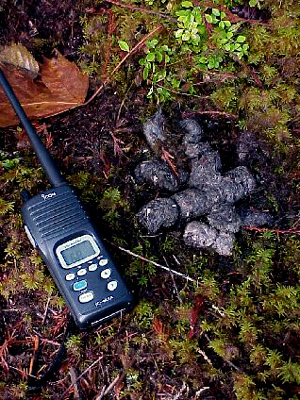
December 18, 2005

(William S. Burroughs – Is Everybody In)
1. Get to the other side of the river. A 100 year storm had washed out bridge access to the southern section of our study area. It had been closed down now for about 3 years. This storm trapped me in the area with landslides and changed the course of the river. The river has a good history of producing Steelhead and killing people who take the dangers lightly. The moving water, glacial temperatures, sweepers (downed logs in the river) and now quicksand were just a few things that needed to be figured in our planning changes.

2. Visit the chute meadows and funnels. Evaluate just what edible plant life was there. The meadows would provide a plentiful food supply, allowing thermo regulation of large bodied animals at the same time. The funnels allowed easy, unseen entrance and egress for animals to visit the meadows.

3. Daily searches of the 26 miles of sand bars along the river. Visiting those sites containing small mammals burrowing beneath the sands and beaver ponds along the shores. Mountain beaver was a very big to do on the horse wranglers list.

4. Deploy the ARU (Automated Recording Unit), conduct control checks with a known distance, direction and power level call blast from base camp. This unit recorded sound, both in the audible range and that from the infrasound level.
5. Deploy 30 camera traps forming a line along the northern side of the river.
6. Investigate all entrance routes to the main study area. Evaluate travel routes, shelter, water and food in these locations.
7. Aerial survey of the site.
8. Collect DNA in the form of hair and scat samples. Hair snares were developed and deployed by John Mionczynski. The simple, but effective devices not only snagged hair from a warm body but also would dig a little bit at the skin, hopefully bringing along with it a follicle, tissue and blood.

9. Visit sites within the study area where historical as well as more modern reports of giant apes have emanated (Cub Lake, White Film, Hairy Pants berry fields, etc.).

About Rick Noll
Rick Noll has been actively searching for the Sasquatch since 1969 and continues his pursuit with extended field trips into the Pacific Northwest's most remote regions. Rick has worked with Peter Byrne, René Dahinden, Grover Krantz, John Green, Jeff Meldrum and the BFRO during all this. He helped with many documentaries on the subject including Animal X: The Skookum Expedition and Sasquatch: Legend Meets Science.
Filed under Bigfoot, Bigfoot Hunter, Cryptozoology, Evidence, Expedition Reports, Extinct, Forensic Science, Media Appearances, Sasquatch, Television